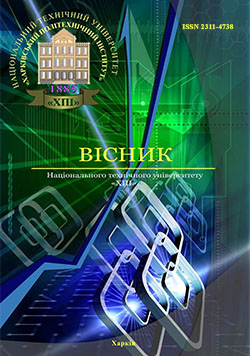DECISION SUPPORT MODEL IN PROJECTS OF COMPLEX OBJECTS PROTECTION POTENTIAL DANGER
DOI:
https://doi.org/10.20998/2413-3000.2016.1174.22Keywords:
complex object model, objects of potential danger, risk, fuzzy logic, uncertainty, security, emergency, facilityAbstract
The article made the simulation of complex technical-organizational systems under conditions of risk, uncertainty and the impact of the turbulence and the model of decision support to assess the safety and operation of complex object level based on fuzzy logic and considered the possibility of using the foundations of fuzzy logic, support decisions taken in the draft protection of objects of potential danger. It was established that the definition of conjunction and disjunction as «max», and «min», respectively, gives great opportunities to minimize the model, and found that when simplified models, there is an opportunity to come to the point where some units "reduced", that is, some nodes are made to the model at the design stage have no impact on the success of the project of protection of objects of potential danger. Proved that the problem to be solved within the framework for building complex object models in design-oriented project management protection facilities need to use the potential danger disjunction and conjunction formally presented in the form of algebraic product and the amount of fuzzy sets, as this does not lead to the loss of nodes and provides conditions that take into account the impact of all input parameters. Considered in terms of advantages and disadvantages of the use of logical operations, as well as the characteristics and properties of the object of potential hazards, to minimize the number of key relationships in the model for optimal project management in assessing and improving the safety of life.References
Getman V. V.,&Buravlov E. P. (2014). Texnogenna bezpeka Ukrayiny`: vid reaguvannya do preventy`vnoyi strategiyi [Technogenic security Ukraine: from response to preventive strategies]. Kyiv: Logos, 130 [in Ukrainian].
Alymov V. T., &Tarasova N. P. (2014). Tehnogennyj risk. Analiz i ocenka [Technological risks. Analysis and evaluation]. Moscow: Akademkniga [in Russian].
Сasti J. (2002). Bol'shie sistemy. Svjazannost', slozhnost' i katastrofy [Connectivity complexity, and catastrophe in large-scale systems] Moscow: World [in Russian].
Belov P. G. (2003). Sistemnyj analiz i modelirovanie opasnyh processov v tekhnosfere [Systems analysis and Modeling hazardous processes in the technosphere] Moscow: Akademia [in Russian].
Ministry of Ukraine of Emergencies, Ministry of Economy, Ministry of Environment and Natural Resources (2007). On approval of the Methodology predict the consequences of the spout (release) of hazardous chemicals in accidents at industrial facilities and transport. zakon3.rada.gov.ua. Retrieved fromhttp://zakon3.rada.gov.ua/laws/show/z0326-01.
Bushuev S. D., Bushueva N. S.,&Yaroshenko R. F. (2012). Model garmonizacii cennostej programmy razvitiya organizacij v usloviyah turbulentnosti okruzheniya [Model of harmonize values development program organizations in the turbulent environment]. Kyiv National University of Construction and Architecture, 10, 9–13 [in Ukrainian].
Bushueva N. S.,& Bushuev S. D. (2007). Proaktivnoe upravlenie proektami organizacionnogo razvitija v uslovijah neopredeljonnosti [Proactive management of projects organizational development in conditions of uncertainty]. Journal of East Ukrainian National University named after Volodymyr Dahl, 22, 17–27 [inRussian].
Ageev A. E. (2006). Organizacionnaja model' upravlenija riskami proektov[The organizational model of risk management projects]. Radio electronic and computer systems, 3, 41–44 [inRussian].
Al-Shukri Ahmed Fathi Mohammed (2003). Analiz istochnikov i faktorov izmenenij v proektah stroitel'stva slozhnyh jenergeticheskih ob’ektov [Analysis of the sources and drivers of change in the construction of complex energy facilities]. Scientific works project management and production development, 3 (8), 64–69 [in Russian].
Rach V. A. (2013). “Nebezpeka/rizik/kriza” yak trіadna sutnіst procesіv rozvitku v suchasnіj ekonomіcі ["The danger /risk/ crisis" as the essence of a process of development processes in the modern economy]. Journal of East Ukrainian National University named after Volodymyr Dahl, 1 (45), 155–160 [in Ukrainian].
Rudenko S. V., HohunskyyV.D.,ChernenkoY.S. (2013). A multidimensional model of the target of the risk function in life safety projects [Mnogomernaja model' celevoj funkcii riska v proektah bezopasnosti zhiznedejatil'nosti]. Safety of human life - education, science, practice: XII international scientific - practical conference. (pp. 203–206) [in Russian].
Tesla Y. M.,&Kubyavka L. B. (2014). Koncepcіja pobudovi ta funkcії sistemi u proti rizikovogo upravlіnnja proektami u programah іnformacіі [The concept of the construction and function of the system against risk in project management programs information]. Proceedings of management of complex systems. Kyiv National University of Construction and Architecture, 19, 93–95 [in Ukrainian].
Druzhinin E. A. (2006). Metodologichni osnovy` ry`zy`k-oriyentovanogo pidxodu do upravlinnya resursamy` proektiv i program rozvy`tku texniky` [Methodological basis of a risk-based approach to resource management projects and programs of technology]. Extended abstract of Doctor’s thesis. Kharkov: National AerospaceUniversityZhukovsky [in Ukrainian].
Kononenko, I. V. (2012). Optimizacija soderzhannja proekta po kriterіjam pribyl', vremja, stoimost', kachestvo, riski [Optimization of the project content by kriterіyam profit, time, cost, quality, risk]. Vostochno-evropeiskyi zhurnal peredovykh tekhnolohyi – East European Journal of advanced technologies, 1/10 (55), 13–15 [inRussian].
Downloads
Published
Issue
Section
License
Copyright (c) 2016 Роман Юрійович СУКАЧ, Юрій Павлович РАК

This work is licensed under a Creative Commons Attribution-NonCommercial-ShareAlike 4.0 International License.
Our journal abides by the Creative Commons copyright rights and permissions for open access journals.
Authors who publish with this journal agree to the following terms:
Authors hold the copyright without restrictions and grant the journal right of first publication with the work simultaneously licensed under a Creative Commons Attribution-NonCommercial-ShareAlike 4.0 International License (CC BY-NC-SA 4.0) that allows others to share the work with an acknowledgement of the work's authorship and initial publication in this journal.
Authors are able to enter into separate, additional contractual arrangements for the non-commercial and non-exclusive distribution of the journal's published version of the work (e.g., post it to an institutional repository or publish it in a book), with an acknowledgement of its initial publication in this journal.
Authors are permitted and encouraged to post their published work online (e.g., in institutional repositories or on their website) as it can lead to productive exchanges, as well as earlier and greater citation of published work.

